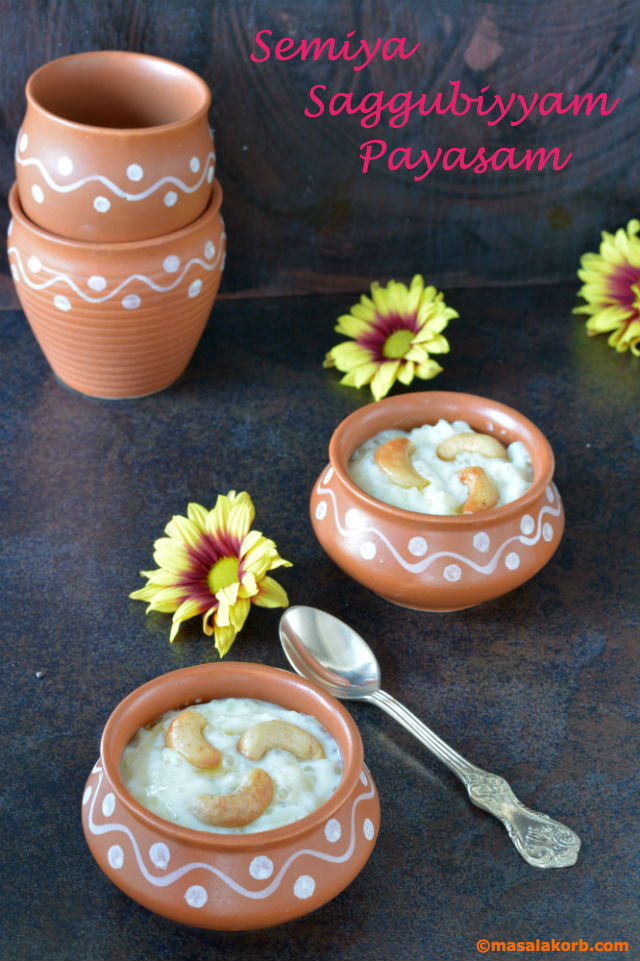 “A very happy Dussehra“ to all of you!! Today’s post has to definitely be a sweet because sweets are an indispensable part of any celebration or festivity. A perfect choice to light up any festive occasion in your house is a simple kheer. This delicious “Semiya Saggubiyyam Payasam“ could be the best, traditional, and yummy way to celebrate dussehra. Don’t get intimidated by the name, it’s nothing but Seviyan Sabudana Kheer or Vermicelli tapioca pudding.
“A very happy Dussehra“ to all of you!! Today’s post has to definitely be a sweet because sweets are an indispensable part of any celebration or festivity. A perfect choice to light up any festive occasion in your house is a simple kheer. This delicious “Semiya Saggubiyyam Payasam“ could be the best, traditional, and yummy way to celebrate dussehra. Don’t get intimidated by the name, it’s nothing but Seviyan Sabudana Kheer or Vermicelli tapioca pudding.
Dussehra or Vijayadashami, is the day that follows the nine days of Navaratri. The name Dussehra is derived from Sanskrit Dasha-hara, which literally means “remover of bad fate”. In fact it is believed that the war between Ram and Ravana went on during these 10 days and Ravana was killed by the hands of Ram on the tenth day. It is called as triumph of virtue over sin or immorality.
The festival of Dussehra is also known as Durga Pooja. In eastern part of India people worship Goddess Durga all the nine days and celebrate Dussehra, as it was on that day that the demon Mahisasura was killed by the Goddess Durga.
In South India, Vijayadashmi holds special significance. The day is auspicious for starting education or any form of art, such as dance and music. All new ventures would begin from Vijayadasami. Even today, some schools take in children for kindergarten sessions starting from Vijayadasami day. People believe anything you start on this particular day will be successful.
Dussehra is celebrated in different ways across India, but the motive remains the same. To spread good cheer and celebrate the victory of good over the evil.
Coming back to today’s recipe, “Semiya Saggubiyyam Payasam“ is a divine treat not only for festivals but also for those occasional indulgences. It is believed that the term payasam is derived from peeyusham which means nectar or ambrosia. Payasa or payasam is also the Sanskrit word for milk. The Payasam dessert has been an essential dish throughout the history of the Indian culinary heritage. It is common to serve during ceremonies, feasts and most celebrations. South Indian traditions dictate that a wedding is not fully blessed if Payasam is not served in a wedding feast.
Traditionally you prepare it as an offering to the gods with rice (vermicelli/Sago or a combination of both) and milk, simmering for hours in brass or clay pots over an open fire. But in today’s modern world, it is very difficult to follow this tradition any more. Garnishes can include fresh and dry fruits as well as nuts, roasted in pure ghee.
Click here to go directly to the video for SEMIYA SAGGUBIYYUM PAYASAM !!
Off to the recipe for “Semiya Saggubiyyam Payasam“.
Step-by-Step process in making “Semiya Saggubiyyam Payasam” :
- Grab the main dry ingredients.
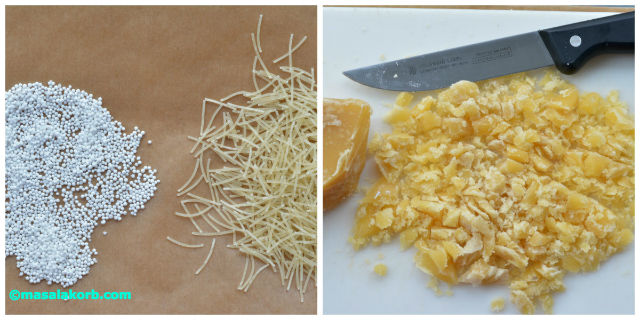
- Add milk a large vessel and boil over medium heat.
- While the milk is boiling get ready with the rest of the prep.
- Dissolve jaggery in ¼ cup of water, bring it to a boil over medium heat and then strain to remove impurities.
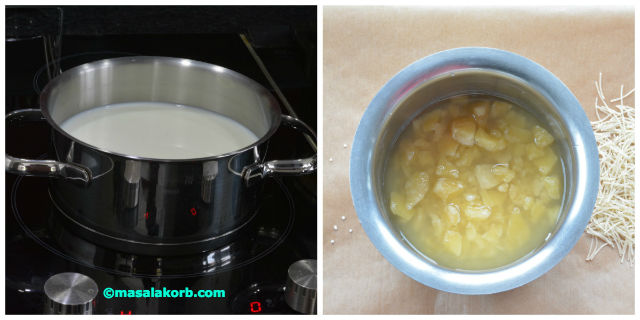
- Wash sago and vermicelli (semiya) and set aside.
- Once the milk starts boiling, add sago/tapioca (saggubiyyam) and cook for 3 to 5 minutes till half done.
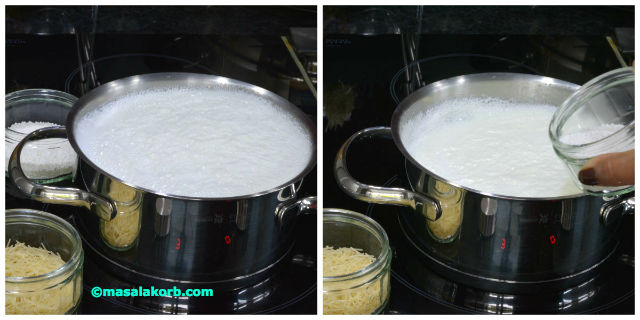
- Now add the vermicelli and cook for 2 to 3 minutes.
- The cooked vermicelli and sago should look like below in the picture.
NOTE:
- You can also roast vermicelli in a teaspoon of ghee till golden brown and use. But I use this variation only when using sugar. For jaggery based payasam, I do not fry vermicelli. Choice is yours.
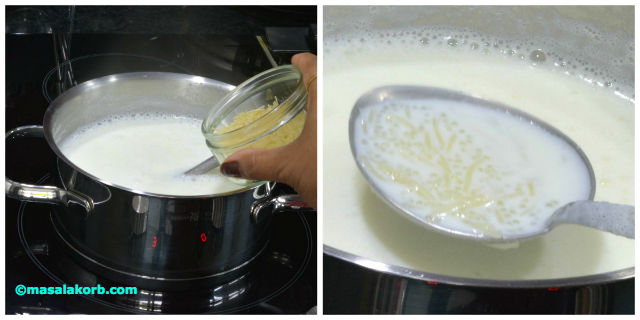
- Now dissolve a tablespoon of rice flour in water and add it to the boiling payasam. Make sure to get the consistency you want.
- Now add in the melted and strained jaggery syrup, give it a stir and turn off the heat.
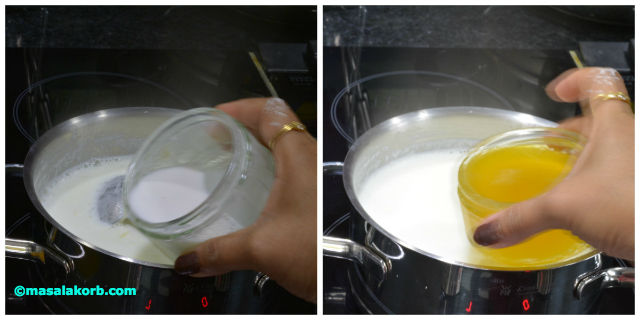
- The consistency I prefer is like in the picture below.
- Crush cardamom seeds and add the powder to the payasam and mix well.
NOTE:
- Do not add too much of rice flour, otherwise payasam becomes very thick. Also keep in mind that payasam anyway becomes thick once it cools down.
- Ensure to turn off heat as soon as you add jaggery syrup, otherwise the payasam may curdle depending on the quality of jaggery.
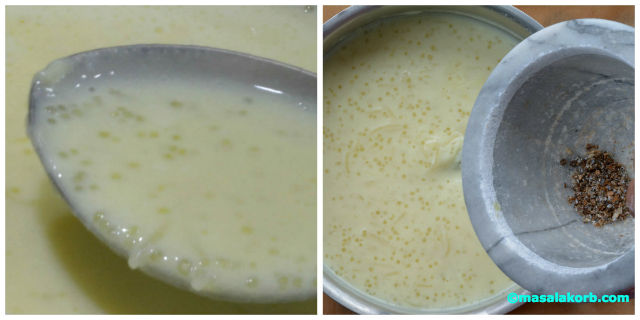
- In another small pan melt 1 teaspoon of ghee over medium heat and fry cashew pieces till golden brown and turn off the heat.
- Finally garnish “Semiya Saggubiyyam Payasam” with fried cashew nuts.
- Serve “Semiya Saggubiyyam Payasam” hot. You can also be serve it cold but it tastes best when hot.
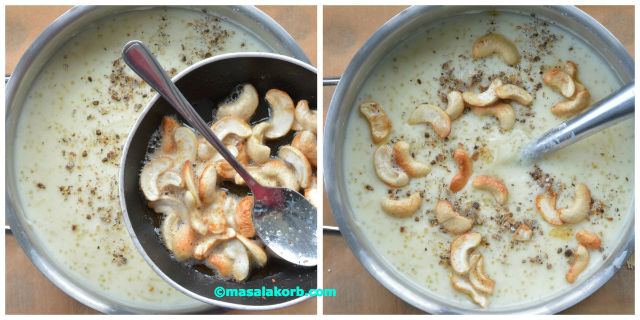
Semiya Saggubiyyam Payasam
Ingredients
- 1 litre whole milk
- ½ cup Vermicelli semiya
- ½ cup Sago saggubiyyam/tapioca
- 1 Tablespoon Rice flour dilutedin ¼ cup of water
- ¾ to 1 cup Jaggery powdered, dissolved in ¼ cup water
- ½ teaspoon cardamom powder
- 10 to 15 cashews halved & fried to golden brown in 1 teaspoon ghee/butter
- 10 raisins optional
Instructions
- Add milk into a large vessel and bring it to a boil over medium heat.
- While the milk is boiling, wash sago and vermicelli with water. Drain the water and set aside.
- Dissolve jaggery in ¼ cup of water, bring it to a boil over medium heat and then stain to remove impurities.
- Once the milk starts boiling, add in sago and cook for 3 to 5 minutes or till half done.
- To this add vermicelli and cook for 2 to 3 minutes.
- Now dissolve a tablespoon of rice flour in water in a small cup and add it to the boiling payasam. Make sure you add just enough to get the desired consistency.
- Now add in the melted and strained jaggery syrup, give it a stir and turn off the heat.
- In another small pan melt 1 teaspoon ghee over medium heat and fry cashews till golden brown and turn off the heat.
- Add cardamom powder and garnish "Semiya saggubiyyam payasam" with fried cashew nuts.
- Serve hot and enjoy. You can also be serve cold but it tastes best when hot.
My Notes:
- Adjust jaggery to suit your taste buds.
- You can substitute whole milk with low fat milk if you are calorie conscious.
- You can also roast vermicelli in a teaspoon of ghee till golden brown and use. But I use this variation only when using sugar. For jaggery based payasam I do not fry vermicelli.
- Do not add too much of rice flour, otherwise payasam becomes very thick. Also keep in mind that payasam anyway becomes thick once it cools down.
- Ensure to turn off heat as soon as you add jaggery, otherwise the payasam may curdle depending on the quality of jaggery.
Many more to come….Stay tuned!!
Happy Cooking 🙂
Cheers!!
Padma.

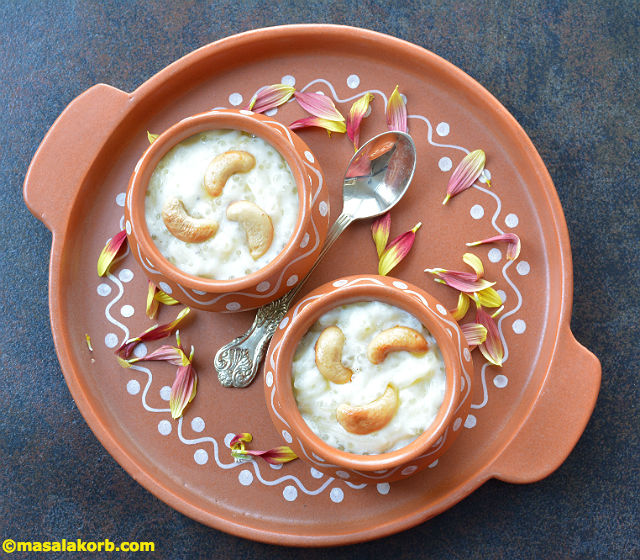
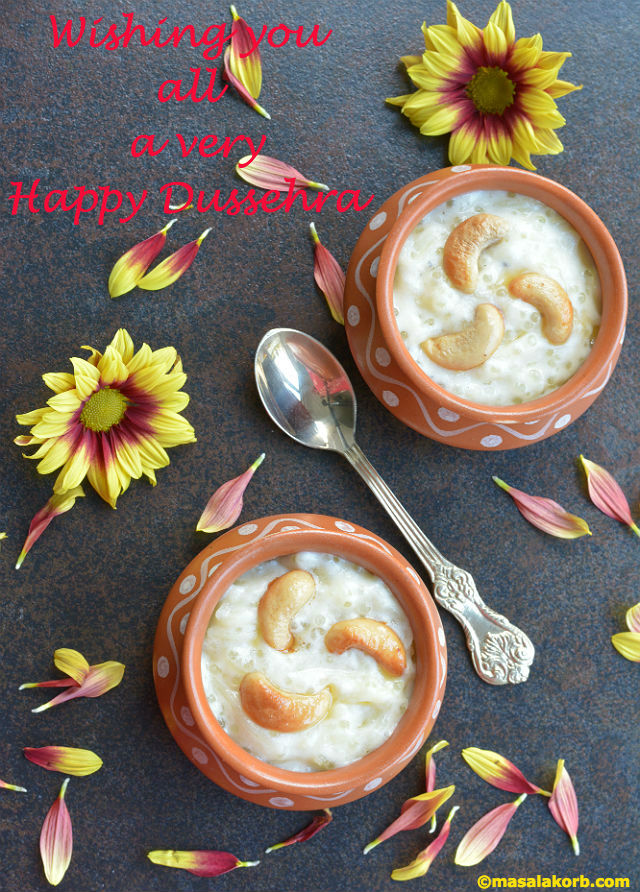
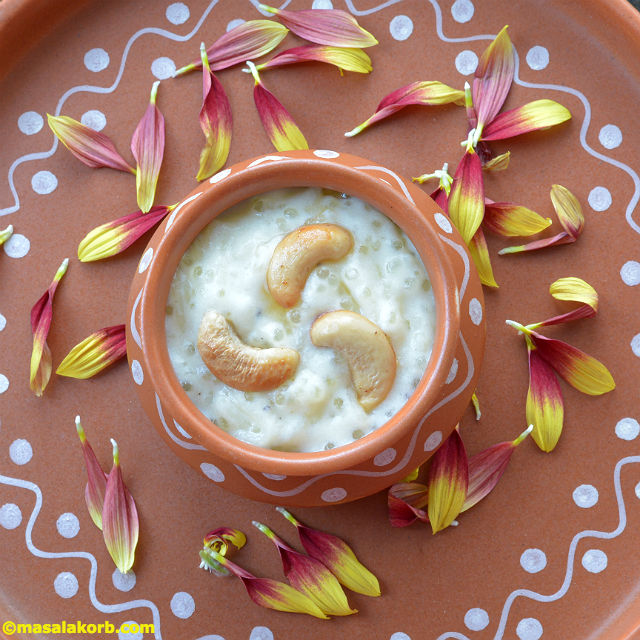
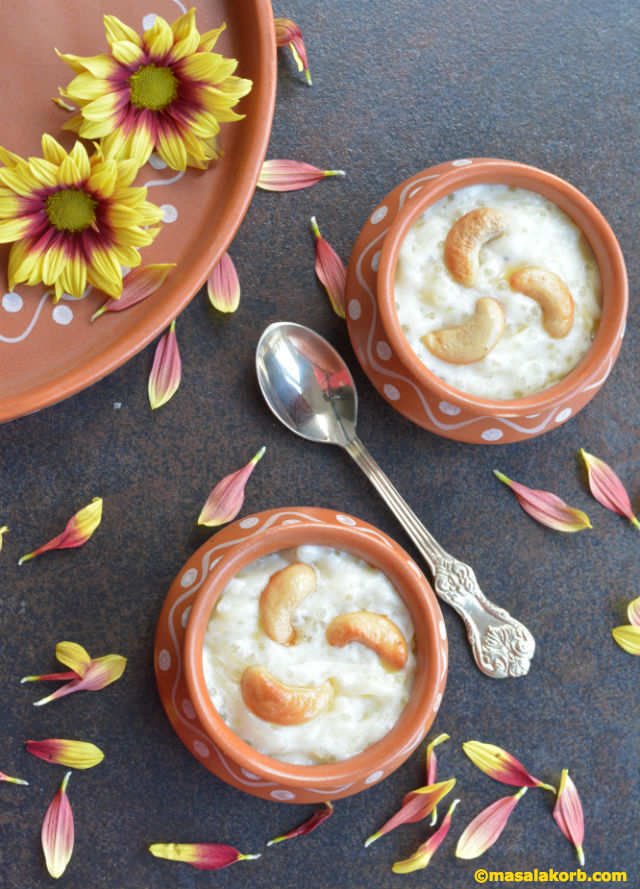
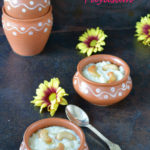
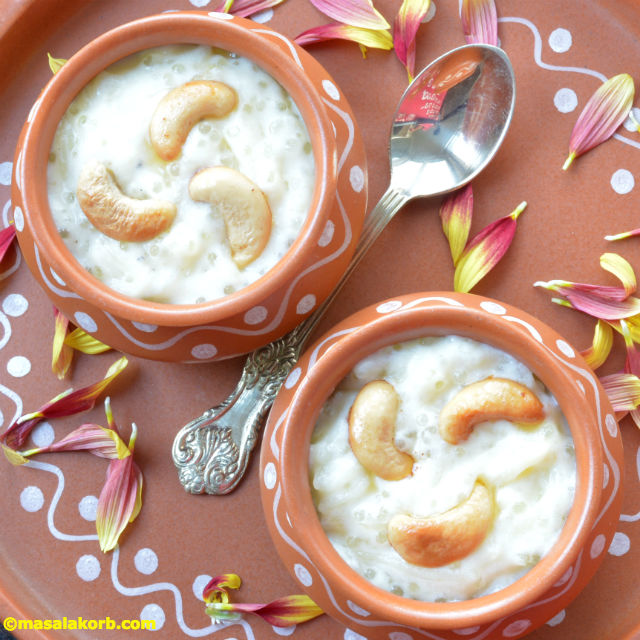
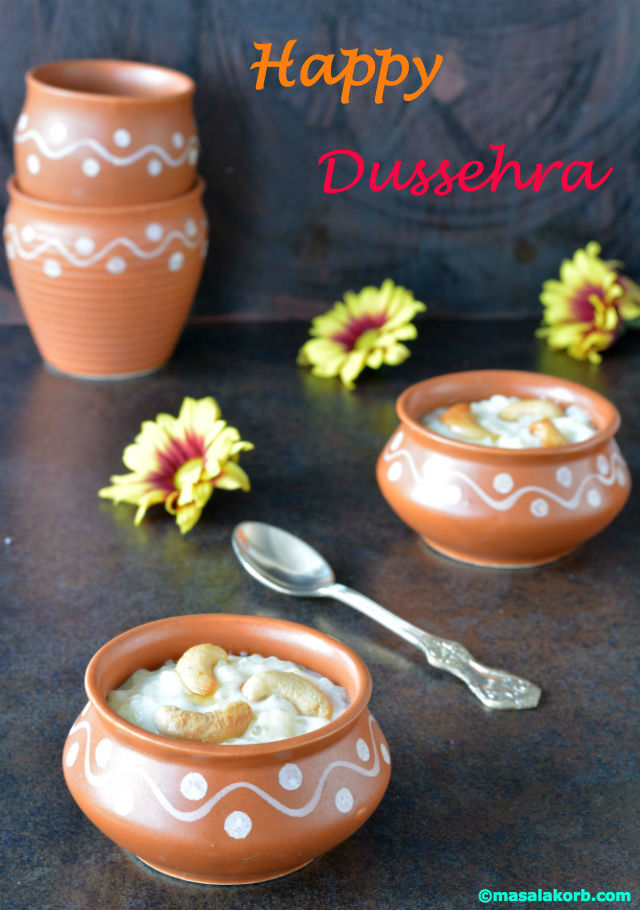
Love the beautiful pots!! payasam looks yum
Thank you dear:)
A slight different semiya payasam.. Love it.. I am going to grab yr mud pots dear.. 🙂
Thank you seena…:)
thick and creamy kheer
Thanks veena:)
Yum! like the combination of sago and vermicelli nice twist with jaggary…… sound tempting:) will try soon:) Loved the picture!
Thanks a bunch dear…do try it and let me know.
Love your presentation, those cute little pots :)) Are they from India?
I have had sabudana kheer and sevai kheer separate, never really had one in combination, will try someday 🙂
Thank you so much dear…u got it right..they r from my last India trip dear…Definitely give it a shot..I’m pretty sure you will love it.
This is one of my favourite dishes . Will try it at the earliest and give you the feed back. The rustic terracotta pots look great and traditional. looking forward to your next post…….
Thanks a ton Raji for taking time to leave suce a lovely comment….Do try it..will wait for your feedback!!
Mmmm, loving this payasam Padma. You combined two of my favorites kheers, so I need to try this ASAP or else you send me a HUGE bowl! 🙂
Oh dear…on my way..I don’t know about the bowl but a HUGE hug from me…Do give it a try anu..I’m sure u will love it..Thank you dear:)
Thats a delicious payasam. Post name made me think like something alien in semiya payasam haha.
Hehe…it’s the name in telugu dear….Thank you 🙂
one of my favorite sweet dish, love it Padma!
Thank you Manali 🙂
So classic payasam, with lot of festive feel, and that rustic mud pots are just so beautiful and traditional…
Thanks a bunch Jeena 🙂
I have to try it. NEver tried making it with jaggery. Yummmy!!
Thank you dear…do try it..In fact I prefer payasam with jaggery!!
This is my favorite payasam… havent had this combination since long and saw it on another blog as well… I guess I should be making some soon… 🙂
Thank you dear…do give it a try!